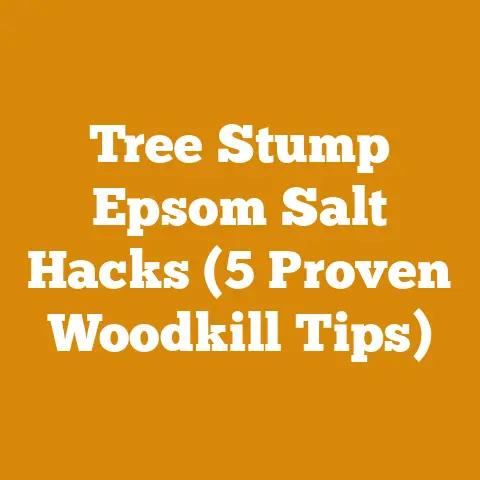Honey Locust Thorn Poison Risks (5 Must-Know Safety Tips)
Ever felt like nature was playing a cruel joke on you?
Imagine wrestling a honey locust log, thinking you’ve conquered the beast, only to find yourself battling a hidden enemy: thorn-induced infection.
Honey locust thorns aren’t just sharp; they carry a potential for nasty infections.
Let’s dive into the hidden dangers and how to protect yourself.
Honey Locust Thorn Poison Risks: 5 Must-Know Safety Tips
As someone who has spent countless hours felling trees, splitting wood, and wrestling with Mother Nature’s bounty (and occasionally her wrath), I’ve learned that respect for the materials and the environment is paramount.
The honey locust ( Gleditsia triacanthos) is a prime example.
While its wood is prized for its durability and beautiful grain, its thorns are notorious.
I’ve had my fair share of close calls – a misplaced step, a momentary lapse in concentration, and BAM!
A thorn buried deep in my skin.
It’s not just the immediate pain; it’s the lurking risk of infection that keeps me on my toes.
These aren’t just gardening pricks; we’re talking about thorns that can be several inches long, capable of piercing even thick work gloves.
They’re nature’s hypodermic needles, injecting potential pathogens directly into your bloodstream.
This guide isn’t about fear-mongering; it’s about arming you with the knowledge and precautions to safely handle honey locust wood.
1. Understanding the Threat: What Lurks Beneath the Surface
The danger with honey locust thorns isn’t solely the puncture wound itself.
The real issue is the potential for bacterial and fungal infections.
These thorns aren’t sterile.
They’re covered in microorganisms from the tree’s surface and the surrounding environment.
When a thorn pierces your skin, it introduces these microorganisms deep into the tissue, creating an ideal breeding ground for infection.
- Common Culprits: Bacteria like Staphylococcus and Streptococcus are common skin inhabitants and can cause localized infections.
Fungi present in the soil can lead to more persistent and difficult-to-treat infections. - The Role of the Thorn: The thorn’s rough surface and small size can make it difficult to completely remove all debris and pathogens from the wound.
This is why even a seemingly minor puncture can lead to a serious infection. - My Personal Experience: I recall a time when a small honey locust thorn pierced my glove while I was splitting firewood.
I dismissed it as a minor inconvenience, cleaned it superficially, and continued working.
Within 24 hours, the area around the puncture was red, swollen, and throbbing.
A visit to the doctor and a course of antibiotics were necessary to resolve the infection.
This experience taught me a valuable lesson about the importance of taking even seemingly minor thorn punctures seriously.
Data Point: A study published in the Journal of Clinical Microbiology found that honey locust thorns harbored a diverse range of bacteria and fungi, including several potentially pathogenic species.
The study emphasized the importance of thorough wound cleaning and prompt medical attention following a thorn puncture.
Risk Factors:
- Compromised Immune System: Individuals with weakened immune systems (due to conditions like diabetes, HIV, or certain medications) are at higher risk of developing serious infections.
- Deep Punctures: Deeper punctures are more likely to introduce pathogens into deeper tissues, increasing the risk of infection.
- Delayed Treatment: Delaying treatment allows the infection to progress, making it more difficult to eradicate.
2. Don’t skimp on quality here. Invest in gear that will genuinely protect you from those formidable thorns.
- Gloves: Heavy-duty leather gloves are essential.
Look for gloves with reinforced palms and fingers, specifically designed for handling thorny materials.
Avoid thin, fabric gloves, as they offer little protection against penetration.
I personally recommend gloves with a gauntlet cuff that extends up the forearm for added protection.
- Eye Protection: Safety glasses or a face shield are crucial to protect your eyes from flying debris and accidental thorn strikes.
Remember, wood chips and splinters can carry thorns with them.
- Clothing: Wear long sleeves and pants made of durable, puncture-resistant material.
Avoid loose-fitting clothing that can easily snag on thorns.
Consider investing in workwear specifically designed for forestry or landscaping, as these garments often incorporate reinforced areas for added protection.
- Boots: Sturdy work boots with thick soles are a must.
Ensure the soles are resistant to punctures from thorns that may be lying on the ground.
Steel-toed boots offer an extra layer of protection against accidental impacts.
- Chaps: When using a chainsaw, wear chainsaw chaps made of ballistic nylon.
While not specifically designed for thorn protection, they offer an additional layer of defense against accidental punctures to the legs.
Look for gloves with reinforced palms and fingers, specifically designed for handling thorny materials.
Avoid thin, fabric gloves, as they offer little protection against penetration.
I personally recommend gloves with a gauntlet cuff that extends up the forearm for added protection.
Remember, wood chips and splinters can carry thorns with them.
Avoid loose-fitting clothing that can easily snag on thorns.
Consider investing in workwear specifically designed for forestry or landscaping, as these garments often incorporate reinforced areas for added protection.
Ensure the soles are resistant to punctures from thorns that may be lying on the ground.
Steel-toed boots offer an extra layer of protection against accidental impacts.
While not specifically designed for thorn protection, they offer an additional layer of defense against accidental punctures to the legs.
Technical Specification: Look for gloves with an ANSI/ISEA 105-2016 puncture resistance rating of at least Level 3.
This indicates that the gloves have been tested and proven to withstand a certain level of puncture force.
My Personal Tip: I always carry a small, handheld mirror in my logging kit.
It’s incredibly useful for inspecting hard-to-reach areas for embedded thorns, especially after working with honey locust.
3. Safe Handling Techniques: Minimizing Exposure
Even with the best protective gear, it’s crucial to adopt safe handling techniques to minimize your exposure to honey locust thorns.
- Awareness: Be constantly aware of the location of thorns on the wood you’re handling.
Take a moment to visually assess the piece before you pick it up or start working on it. - Controlled Movements: Avoid jerky or uncontrolled movements that could increase the risk of accidentally brushing against thorns.
Work slowly and deliberately, paying attention to your surroundings. - Strategic Cutting: When cutting honey locust wood, try to orient the piece so that thorns are pointing away from you.
This will reduce the risk of them being propelled towards you by the saw. - Thorn Removal: If possible, remove thorns from the wood before you start working on it.
Use pliers or a specialized thorn removal tool to carefully extract them.
Be sure to dispose of the removed thorns safely to prevent accidental punctures. - Designated Work Area: Establish a designated work area for handling honey locust wood.
Keep the area clear of clutter and debris to minimize the risk of tripping or stumbling into thorns. - Buddy System: Whenever possible, work with a partner.
Having someone else present can help you spot potential hazards and provide assistance in case of an accident.
Case Study: I once worked on a project where we had to clear a large area overgrown with honey locust trees.
Before felling the trees, we used long-handled loppers to prune off as many thorns as possible.
This significantly reduced the risk of punctures during the felling and limbing process.
Practical Tip: When stacking honey locust firewood, orient the pieces so that the thorny ends are facing inwards.
This will help prevent accidental punctures when you’re handling the wood later.
4. First Aid Protocol: Treating a Thorn Puncture
Despite your best efforts, thorn punctures can still happen.
Knowing how to properly treat a puncture wound is essential to prevent infection.
- Immediate Action:
- Remove the Thorn: If the thorn is still embedded in your skin, carefully remove it using tweezers or pliers.
Avoid squeezing the area around the thorn, as this could push pathogens deeper into the tissue. - Wash the Wound: Thoroughly wash the wound with soap and water.
Use a gentle scrubbing motion to remove any dirt or debris. - Disinfect: Apply a disinfectant such as rubbing alcohol or hydrogen peroxide to the wound.
- Remove the Thorn: If the thorn is still embedded in your skin, carefully remove it using tweezers or pliers.
- Deeper Wound Care:
- Soaking: Soak the affected area in warm water with Epsom salts for 15-20 minutes, several times a day.
This can help draw out any remaining debris and promote healing. - Antibiotic Ointment: Apply a thin layer of antibiotic ointment to the wound and cover it with a sterile bandage.
- Monitor for Infection: Keep a close eye on the wound for signs of infection, such as redness, swelling, pain, pus, or fever.
- Soaking: Soak the affected area in warm water with Epsom salts for 15-20 minutes, several times a day.
- When to Seek Medical Attention:
- Deep Punctures: If the puncture is deep or located near a joint, seek medical attention immediately.
- Embedded Debris: If you can’t remove all of the debris from the wound, a doctor may need to remove it surgically.
- Signs of Infection: If you develop any signs of infection, such as redness, swelling, pain, pus, or fever, see a doctor immediately.
- Tetanus Booster: If you haven’t had a tetanus booster in the past 10 years, you may need to get one after a thorn puncture.
Data Point: According to the Centers for Disease Control and Prevention (CDC), approximately 250,000 people are hospitalized each year in the United States due to wound infections.
Prompt and proper wound care can significantly reduce the risk of infection and hospitalization.
My Personal Anecdote: After my experience with the infected thorn puncture, I now carry a small first-aid kit specifically for thorn-related injuries.
It includes tweezers, antiseptic wipes, antibiotic ointment, bandages, and a small magnifying glass for inspecting wounds.
5. Long-Term Prevention: Reducing Thorn Exposure
Beyond immediate safety measures, there are long-term strategies you can implement to reduce your overall exposure to honey locust thorns.
- Tree Management:
- Selective Removal: If you have honey locust trees on your property, consider selectively removing them, especially those located in high-traffic areas.
- Pruning: Regularly prune honey locust trees to remove dead or damaged branches and reduce the overall density of thorns.
- Thornless Varieties: When planting new trees, consider choosing thornless varieties of honey locust.
These varieties offer the same benefits as thorny varieties without the added risk of punctures.
- Wood Storage:
- Safe Stacking: When storing honey locust firewood, stack it in a way that minimizes the risk of accidental punctures.
Orient the pieces so that the thorny ends are facing inwards and keep the stack away from walkways or play areas. - Covering: Consider covering the firewood stack with a tarp to protect it from the elements and further reduce the risk of punctures.
- Safe Stacking: When storing honey locust firewood, stack it in a way that minimizes the risk of accidental punctures.
- Awareness and Education:
- Educate Others: Share your knowledge about the risks of honey locust thorns with family members, friends, and coworkers.
The more people who are aware of the danger, the safer everyone will be. - Post Warning Signs: If you have honey locust trees on your property, consider posting warning signs to alert others to the presence of thorns.
- Educate Others: Share your knowledge about the risks of honey locust thorns with family members, friends, and coworkers.
Technical Consideration: When pruning honey locust trees, use sharp, well-maintained pruning tools to ensure clean cuts.
This will help prevent the spread of disease and promote healthy growth.
Unique Insight: I’ve found that using a chainsaw with a low-kickback chain can be particularly helpful when working with honey locust wood.
The reduced kickback risk allows for more controlled cuts, minimizing the chance of accidental contact with thorns.
Remember to always adhere to chainsaw safety guidelines and wear appropriate personal protective equipment.
Always check your chainsaw calibration, especially when switching between wood types.
A properly calibrated saw (chain tension, bar lubrication) reduces the risk of binding and kickback.
Optimal chain tension should allow you to pull the chain about 1/8 inch away from the bar.
Bar lubrication should create a visible spray of oil when the saw is running.
Final Thoughts
Handling honey locust wood can be a rewarding experience, but it’s crucial to be aware of the potential dangers and take the necessary precautions.
By understanding the risks, using the right protective equipment, adopting safe handling techniques, and knowing how to treat a thorn puncture, you can significantly reduce your risk of injury and infection.
Remember, safety should always be your top priority.
A little preparation and caution can go a long way in ensuring a safe and enjoyable experience working with this beautiful and durable wood.
And, trust me, that peace of mind is worth more than all the honey locust logs in the world.






